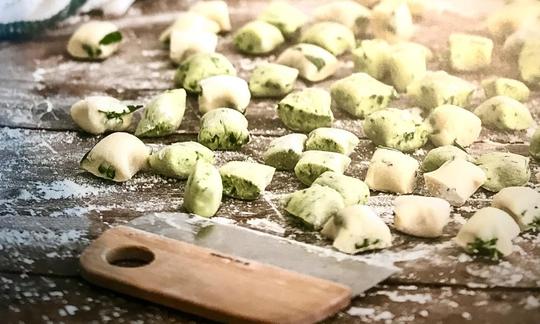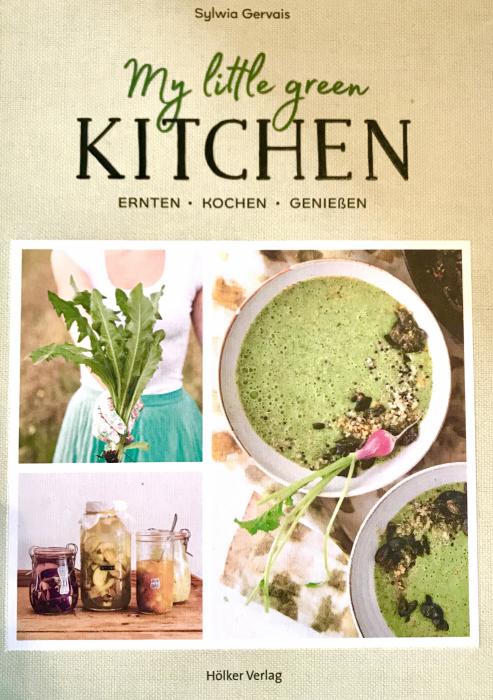Wild Garlic Gnocchi with Spelt Flour
vegan
Ingredients (for servings, )
| 18 oz | Russet potatoes, raw (organic?) |
| 1 ⅜ oz | Wild garlic, raw (organic?) |
| 5 ½ oz | Spelt flour, light (type 630 or D 700, organic?) |
| 1 dash | Nutmeg, ground or grated (raw, organic?) (0.00 oz) |
| 1 dash | Table salt (table salt, raw?, organic?) (0.01 oz) |
| 1 dash | Black pepper (organic?, raw?) (0.00 oz) |
| 1 tbsp | Rapeseed oil, refined (organic?) (0.49 oz) |
Equipment
- vegetable peeler
- skillet (frying pan)
- stove
- saucepan
- potato ricer or potato masher
- skimmer
Type of preparation
- cook
- fry
- chop or grind
- peel
- knead
Preparation
Preparing the potatoes
Peel the potatoes and cook in plenty of water until soft, drain and leave to cool. Wash the wild garlic well. Chop one half coarsely and the other half very finely.The author recommends the use of floury potatoes.
Preparation of the gnocchi
Press the cold potatoes through a potato ricer (alternatively use a masher) and divide into two bowls. Put the roughly chopped wild garlic in one bowl and the finely chopped wild garlic in the other bowl.Add half of the flour, season with nutmeg, salt and pepper and knead into a gnocchi dough. Dust the work surface with flour. Form finger-thick rolls from the dough and use a knife to cut these into finger-width gnocchi.
Finish and serve gnocchi
Bring water to the boil in a large pot. Add the gnocchi to the water in batches and cook until they rise to the surface.Remove with a slotted spoon and allow to cool and dry on a kitchen towel. Finally, heat the oil in a pan and fry the gnocchi.
The author uses olive oil instead of the rapeseed oil we specify. Information about the two oils can be found under Tips.
|
Nutritional Information per person
Convert per 100g
|
2000 kcal | |
|---|---|---|
| Energy | 363 kcal | 18.2% |
| Fat/Lipids | 5.5 g | 7.9% |
| Saturated Fats | 0.49 g | 2.5% |
| Carbohydrates (inc.dietary fiber) | 70 g | 25.8% |
| Sugars | 1.8 g | 2.0% |
| Fiber | 4.4 g | 17.8% |
| Protein/Albumin | 10 g | 20.6% |
| Cooking Salt (Na:62.8 mg) | 159 mg | 6.6% |
| Essential micronutrients with the highest proportions | per person | 2000 kcal | |
|---|---|---|---|
| Vit | Vitamin B6 (pyridoxine) | 0.76 mg | 54.0% |
| Min | Manganese, Mn | 0.93 mg | 46.0% |
| Prot | Tryptophan (Trp, W) | 0.11 g | 43.0% |
| Elem | Potassium, K | 812 mg | 41.0% |
| Vit | Vitamin C (ascorbic acid) | 30 mg | 37.0% |
| Prot | Threonine (Thr, T, irreversibly transaminated) | 0.31 g | 34.0% |
| Prot | Isoleucine (Ile, I) | 0.38 g | 31.0% |
| Prot | Valin (Val, V) | 0.48 g | 30.0% |
| Vit | Vitamin B1 (Thiamine) | 0.31 mg | 29.0% |
| Prot | Phenylalanine (Phe, F) | 0.45 g | 29.0% |
Detailed Nutritional Information per Person for this Recipe
The majority of the nutritional information comes from the USDA (US Department of Agriculture). This means that the information for natural products is often incomplete or only given within broader categories, whereas in most cases products made from these have more complete information displayed.
If we take flaxseed, for example, the important essential amino acid ALA (omega-3) is only included in an overarching category whereas for flaxseed oil ALA is listed specifically. In time, we will be able to change this, but it will require a lot of work. An “i” appears behind ingredients that have been adjusted and an explanation appears when you hover over this symbol.
For Erb Muesli, the original calculations resulted in 48 % of the daily requirement of ALA — but with the correction, we see that the muesli actually covers >100 % of the necessary recommendation for the omega-3 fatty acid ALA. Our goal is to eventually be able to compare the nutritional value of our recipes with those that are used in conventional western lifestyles.
| Essential fatty acids | per person | 2000 kcal |
|---|---|---|
| Alpha-Linolenic acid; ALA; 18:3 omega-3 | 0.47 g | 24.0% |
| Linoleic acid; LA; 18:2 omega-6 | 1.2 g | 12.0% |
| Essential amino acids | per person | 2000 kcal |
|---|---|---|
| Tryptophan (Trp, W) | 0.11 g | 43.0% |
| Threonine (Thr, T, irreversibly transaminated) | 0.31 g | 34.0% |
| Isoleucine (Ile, I) | 0.38 g | 31.0% |
| Valin (Val, V) | 0.48 g | 30.0% |
| Phenylalanine (Phe, F) | 0.45 g | 29.0% |
| Leucine (Leu, L) | 0.62 g | 26.0% |
| Lysine (Lys, K, irreversibly transaminated) | 0.37 g | 20.0% |
| Methionine (Met, M) | 0.16 g | 17.0% |
| Vitamins | per person | 2000 kcal |
|---|---|---|
| Vitamin B6 (pyridoxine) | 0.76 mg | 54.0% |
| Vitamin C (ascorbic acid) | 30 mg | 37.0% |
| Vitamin B1 (Thiamine) | 0.31 mg | 29.0% |
| Vitamin B9, B11 (Folate, as the active form of folic acid) | 52 µg | 26.0% |
| Vitamin B3 (Niacin) | 3.8 mg | 24.0% |
| Vitamin B5 (Pantothenic acid) | 1.2 mg | 19.0% |
| Vitamin E, as a-TEs | 1.8 mg | 15.0% |
| Vitamin K | 8.3 µg | 11.0% |
| Vitamin B2 (Riboflavin) | 0.12 mg | 8.0% |
| Vitamin B7 (Biotin, ex vitamin H) | 2.8 µg | 6.0% |
| Vitamin A, as RAE | 40 µg | 5.0% |
| Essential macroelements (macronutrients) | per person | 2000 kcal |
|---|---|---|
| Potassium, K | 812 mg | 41.0% |
| Phosphorus, P | 160 mg | 23.0% |
| Magnesium, Mg | 58 mg | 15.0% |
| Sodium, Na | 63 mg | 8.0% |
| Calcium, Ca | 36 mg | 5.0% |
| Essential trace elements (micronutrients) | per person | 2000 kcal |
|---|---|---|
| Manganese, Mn | 0.93 mg | 46.0% |
| Copper, Cu | 0.24 mg | 24.0% |
| Iron, Fe | 2.4 mg | 17.0% |
| Zinc, Zn | 1.3 mg | 13.0% |
| Fluorine, F | 23 µg | 1.0% |
| Selenium, Se | 0.67 µg | 1.0% |
| Iod, I (Jod, J) | 0.43 µg | < 0.1% |
My Little Green Kitchen - Harvest. Cook. Enjoy by Sylwia Gervais features classic and creative dishes with a focus on regional and seasonal ingredients.
Since this book is written in German, a description is omitted here. If you are interested, please switch to German in the menu.
The wild garlic gnocchi with spelt flour are a successful spring variation of the traditional gnocchi.
Portion size: The original recipe is for 2 portions. Because of the quantity, we have extended it to 3, as you usually eat it with a sauce (eg pesto etc.). However, if you are very hungry, you can take this into account when shopping.
Nutrient profile: According to GDA guidelines, one portion of this recipe covers around 50% of the average daily requirement of vitamin B6 and manganese and more than ⅓ of that of tryptophan and potassium. The stated vitamin C content may be lower, however, as a certain amount is destroyed when the wild garlic is cooked. It should also be noted that removing the potato peel results in a loss of certain ingredients. The ratio of omega-6 to omega-3 fatty acids is 3:1, below the target maximum value of 5:1.
Potatoes: The starchy potato, originally from South America, is one of the most important staple foods. A distinction is made between waxy, predominantly waxy and floury potatoes. For this recipe, it is best to use floury potatoes.
Spelt: Spelt is a close relative of soft wheat. However, there are differences in the gluten composition. For example, spelt does not contain ω-gliadin, which has been identified as the main trigger for allergic reactions. However, there are only minimal differences between spelt and wheat in terms of the content of fat and fatty acids, amino acids, vitamins and minerals, which probably do not go beyond the natural range of variation. Only the silica content of spelt is significantly higher than that of wheat.
Wild garlic: Wild garlic is very well known as a vegetable, spice and medicinal plant. The entire plant is edible, but the leaves are the ones that are used most often. When the leaves are smaller, they are very tender and particularly aromatic. If the wild garlic is in bloom at the time of harvest, the leaves are usually a little firmer. In spring cooking, it is enjoyed as a soup, in salads, as a vegetable or as a spice. If it is heated, the sulphurous substances change and it loses its special garlic-like taste.
Oils in comparison: We chose refined rapeseed oil instead of olive oil because it has a good ratio of omega-6 (LA) to omega-3 fatty acids (ALA). For comparison, olive oil has a LA:ALA ratio of 11-12:1, whereas the ratio of the two fatty acids in refined rapeseed oil is only 3:1. Information on an optimal ratio of essential fatty acids and general information on common nutritional errors in vegan and raw diets can be found at the following link: Vegans often eat unhealthily. Avoidable nutritional errors.
Cold-pressed oils are not suitable in this case, as they can only be heated slightly - in the case of cold-pressed rapeseed oil, up to a maximum of 120 °C - otherwise harmful substances are created. See the following link ( cold-pressed rapeseed oil).
Collecting tips for wild garlic: Wild garlic can be found wild in almost all of Europe and is in season in Switzerland from March to May. It is well known that there is a risk of confusion with the extremely poisonous leaves of the lily of the valley, the autumn crocus and the spotted arum. The typical smell that arises when the leaves are rubbed can be used to identify wild garlic. However, this only helps at the beginning, as the smell sticks to your hands. Another option is to look at the leaves. While the autumn crocus and the lily of the valley have several leaves on one stem, wild garlic has only a single leaf per stem. Particularly in areas where the fox tapeworm is prevalent, you should wash the leaves thoroughly before use.
Wild garlic pesto: To serve, you can use homemade wild garlic pesto (you can find a recipe for this in the same book on page 32).
Alternatively, you can use the hemp pesto from the recipe Zucchini Spaghetti with Hemp Pesto and Almond Parmesan or a simple homemade tomato sauce.




